Adjustable RPM Speeds, Hot Burrs, & Mythos Filter Coffee
Our number one goal has always been to learn more than what we had known the day before. Solving the riddle of coffee brewing is a one way road, but as long as we attempt to understand it more, we can brew even tastier coffees while we venture down this road.
What has been interesting us for a long while is the effects on grinding temperature - I believe it is the only “true” way to modify a grinders distribution profile and flavor with a single burr.
You may be thinking “well, what about RPM speed?” The fact is, changing your burrs RPM speed doesn’t (but sometimes does) exactly change your grinders distribution profile, it just does the same thing as moving your grinders grind size finer or coarser. People with access to laser diffraction machines (which can be hundreds of thousands of dollars) are realizing this, and the hype associated to grinders with RPM adjustment isn’t actually needed at all… BUT for some burrs sets, possibly high fines producing ones, they are finding it does considerably change the distribution unlike adjusting grind size would. Basically, at this current moment, it’s a toss up if RPM control is even necessary. We will be hearing a lot more about this in the coming year once everyone gets on board.
SO this leads us to the importance of grinding and bean temperature, which we know for sure frozen coffees (especially at dry ice or liquid nitrogen temps) can make a significant difference in grind distribution that the same burr set simply cannot do just by adjusting grind size.
What is thought to happen to beans as they are being ground at different temperatures is that the temperature is making the coffee beans act more or less like plastic and more or less brittle, depending on high or low grinding temps, which changes the way the bean breaks…hence, altering the flavor of your coffee in ways that adjusting your grinders burr spacing, or even sometimes adjusting your rpm speed, cannot do.
We have begun to notice this difference in our recent pour over tests. A cold Mythos burr produces much more texture, body, and lack of clarity whereas a hot Mythos burr produces the opposite kind of sensory experience. Keep in mind this will take many more tests to conclude.
We especially notice this difference in pulling espresso in the morning vs mid-day when our burrs are hotter. As the burrs get hotter, and the burr spacing gets smaller to keep the same shot time, the more we have noted to taste clearer and crisper acidic flavors, with still the great thick body and texture we had in the morning. Of course, this is very difficult to prove unless we A/B side by side with our same palate we had in the morning (our taste ability decreases throughout the day, and we cannot grind hot and cold since the grinder takes about a full day to reach a stable hot burr temp).
There is a lot going on with the Mythos’s ability to make outstanding coffees throughout multiple temperature ranges and (what we believe to be) different distribution profiles reflecting those temperature changes.
This grinder is by far our favorite we’ve tested for espresso. It produces the 1:1.5-1:2.2 ratios, higher extractions, and longer (2bar) pre-infusion times / (7.5bar) shot times paired with high alkalinity brewing water that we believe are needed to make light “filter-roasted” coffee cut right through milk and showcase the coffees flavor. It also makes outstanding non-milk-based espresso with such a low margin for grind size error.
This grinder looks (and tastes…lol) like it’ll be sitting on our bars to represent some of the worlds finest coffees for many more years to come! We look forward to seeing data in the coming years that can help represent our findings for hotter burr temps. In the mean time, we’ll just enjoy the coffee!
-Connor
